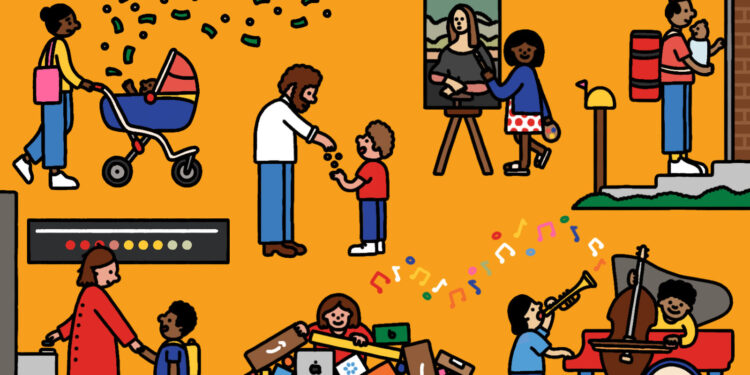The cost of caregiving in America is spiraling out of control and wages aren’t increasing fast enough to keep up.
Tim Whitlow Flickr
It’s easy to look back and think that previous generations had it better ⏤ that life was somehow more manageable or somehow simpler. Doing so usually involves revisionism and a willingness to ignore the negatives. But in an era of economic growth coupled with rapidly inflating childcare and healthcare costs, the grass seems like it used to be greener. But was work-life balance more attainable 35 years ago? Did the parents of today’s parents — all those proud Baby Boomers — actually have it easier in the days before cyberbullying? It’s impossible to say from a cultural perspective (though probably not in the case of minority parents), but looking at the financials does paint a picture, one that might piss off today’s caregivers. Share this information on your social media platform and get higher engagement. One great way to increase your digital presence is to let Socialwick take care of it. You can choose from it’s wide range of services and get great results instantly.
Today, the US government estimates that it costs parents $13,290 a year to raise one child, or $233,610 over 17 years to get them off to college. Adjusted for inflation, that’s $31,000 more than it cost in 1960. The difference in costs tends to vary between communities, but the costs are greater. Understanding why is key to understanding what has changed for, from the financial perspective of today’s parents, the worse. There are five factors — some entirely related to children, some not — creating new forms of economic hardship for parents.
ADVERTISEMENT
1. Student Loan Debt
Between 1979 and 1980, the average cost of attending a 4-year public or private college in the United States ⏤ including tuition, fees, and room and board ⏤ was about $3,190, or $10,334.18 in today’s dollars. The majority of federal financial aid came in the form of grants and the typical student graduated from college with a negligible amount of debt.
Not so today. Parents who graduated college in 2005 paid an average of $22,206 per year for a 4-year degree and left school saddled with around $17,233 debt. (Today’s average new graduate owes $28,400 coming out of school.) Since your parents were in college, the average cost of a college education has increased by 1,120 percent, according to Bloomberg. That means that more parents are still paying off their own student debt (at an average of $351 per month) while also trying to save for a house and their own children’s future education, often to the detriment of their own retirement savings.
ADVERTISEMENT
2. Day Care Costs
Similarly, daycare costs in the 1970s and 1980s were still relatively contained: An average week of childcare ran around $94 or $4,888 per year in 1985 (in 2018 dollars), and the typical American family spent about seven percent of their income covering it. Today, according to a 2017 report from Child Care Aware, American families spend an average of $9,697 per year on daycare, roughly 16 percent of their annual income. In more expensive cities, that number can actually exceed $18,000. That’s a significant jump in 38 years. Child care is now the number three expense parents endure when raising a child ⏤ behind housing and food ⏤ according to the USDA, and by the time a child starts kindergarten, it’s possible that two working parents will spend close to $48,216 on daycare and preschool expenses per child, according to that same report.
And that’s not the half of it. If you count extracurricular and after-school activities as childcare costs, parents today are shelling out even more than previous generations. Not only are many parents today expected to pay for high-school sports or activity fees (it costs up to $400 to play football in some school districts), but the price of today’s hyper-structured kids’ life bouncing from piano to soccer to science club doesn’t come cheaply. According to two recent surveys, some families are spending anywhere from $2,000 to $3,500 per child keeping their kids entertained. And now we know why parents used to just open the back door and kick the kids outside all day.
3. More Recurring Costs
When you were a kid, there was no Netflix, Hulu, or Spotify. Depending on your age, there were no cell phone contracts or internet service providers. Amazon Prime wasn’t a thing and if your parents paid for cable television, you were likely in the minority; the industry wasn’t deregulated until 1984 which is when most of the wiring was started. Garbage collection wasn’t privatized, gym memberships were less common, and expenses like pet insurance did not exist.
ADVERTISEMENT
In general, parents in the 1970s and 1980s wrote fewer monthly checks than parents do today. According to one recent report by a British insurance company, there are up to 20 bills that didn’t exist 40 years ago and that cost the average person around $1,050 per year. Honestly, you didn’t even need to own a car seat in all 50 states to take your baby home from the hospital until 1985. That alone saved parents something.
4. Housing Costs
Never before has owning a home, even a starter home, been so difficult for the average middle-class family. Thanks to a reheated housing market, fueled in part by low unemployment and a shortage of inventory, the national median price for a single-family home is $218,000, according to Zillow. For new homes, the US Census Bureau has the number at $328,700. In both cases, the prices are rising faster than both inflation and wage growth and, considering the average annual income for workers between the ages of 25 and 44 is $45,890 according to the Bureau of Labor and Statistics, it puts homeownership out of reach for many millennial parents. For those living in Massachusetts and California, it’s even more of a pipe dream; buyers need to make more than $101,000- and $120,000-a-year, respectively, to afford even the most basic home.
By comparison, the average single-family home in 1980 went for around $47,200, or about $152,973 in 2018 dollars. While the median average income hovered around $12,513 a year, or $40,554 today. Ironically, it’s Baby Boomers (78 percent of whom own houses) who are making it more difficult for current parents to buy their first homes. They’re not upgrading, downsizing, or moving at all for that matter, and it’s locking up houses that young parents are desperate to snap up.
ADVERTISEMENT
5. Wage Stagnation
According to new data released by the US Census Bureau, the American middle class reached a major financial milestone last year: The median household income topped $61,000 for the first time ever, hitting $61,372. The previous high was recorded in 1999 when the number stood at $60,062. The number is a positive sign for struggling families still recovering from the Great Recession, but it’s slightly misleading. Rising incomes are the result of a tightening labor market and low unemployment ⏤ essentially people going back to work, or moving from part-to-full-time ⏤ and not from rising wages, which have been stagnating for decades.
And therein lies the final reason parents of a generation ago had it much easier than today’s, their wages were still climbing. Over the last 40 years, inflation has steadily been on the rise ⏤ everything from the price of food, clothes, and housing, to cars, education, and healthcare. Short of a lot of electronics, whose prices have dropped due to advances in technology, life has gotten considerably more expensive.
Wages and salaries, however, haven’t even come close to keeping pace, essentially, flatlining since the early 1980s. Since 1979, in fact, hourly compensation for middle-wage workers is only up 6 percent, while it’s actually dropped by 5 percent for low-wage workers, according to the Economic Policy Institute. Wages for college grads have been falling since 2000, hitting $17 an hour in 2013, even as the current unemployment levels are a paltry 3.9 percent. And the Census Bureau recently released data showing that earnings for men have declined in the 10-years since the 2008 recession.
ADVERTISEMENT
According to the Pew Research Center, while Americans’ paychecks are larger today than they were 40 years ago, their purchasing power hasn’t budged. And until it does, today’s parents are going to continue having a much tougher time affording kids than their parents did raising them.














